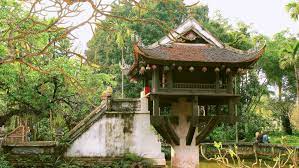Top experience you may interested in:
- Hue to Hoi An motorbike tour via Hai Van pass
- Hue to Hoi An motorbike rental
- Hoi An to Hue motorbike rental
One Pillar Pagoda – A Unique Cultural and Architectural Icon of Hanoi
When mentioning impressive architectural structures, one cannot overlook the One Pillar Pagoda. In 2012, the Asian Record Organization officially recognized thePagoda as the “Most Unique Architecture of a Pagoda in Asia.” It was built in the image of a blooming lotus, symbolizing the purity and nobility of Buddhist teachings.
In Hanoi, there is one tourist destination that you cannot miss – the One Pillar Pagoda. This pagoda not only boasts the most unique architecture in Asia but is also a spiritual destination and a cultural symbol of Hanoi with a history of thousands of years. Let’s explore the One Pillar Pagoda in Hanoi in the following article!
 Introduction to One Pillar Pagoda: Address, Opening Hours & Ticket Price
Introduction to One Pillar Pagoda: Address, Opening Hours & Ticket Price
Hanoi tourism has long been appealing to visitors, not only for its distinctive cuisine but also for its many historical landmarks and sacred pagodas. Some of the most famous pagodas in the capital include the One Pillar Pagoda, Tran Quoc Pagoda, and Phuc Khanh Pagoda.
Where is the One Pillar Pagoda? The Pagoda is located in Ba Dinh District, on a street bearing the same name – One Pillar Pagoda Street, just behind Ong Ich Khiem Street. The pagoda is situated within the precinct of Ho Chi Minh’s Mausoleum and Ba Dinh Square. Consequently, the opening hours for tourists depend on the schedules of these two places. The One Pillar Pagoda welcomes visitors from 7:00 AM to 6:00 PM daily.
If you are a Vietnamese visitor coming for worship, Buddhist ceremonies, or sightseeing, there is no admission fee. However, foreign visitors need to purchase tickets priced at 25,000 VND per person.
Tourists have various transportation options to reach the One Pillar Pagoda:
- If you are using your private vehicle, you can follow directions on Google Maps. If you prefer not to navigate yourself, you can call a taxi or use Grab to be taken directly to the site.
- Alternatively, you can take a bus to save costs. Bus routes 09ACT, 09A, and 18 all have stops at 15A Le Hong Phong Street, and you can walk about 200 meters to reach the pagoda.
History & Legend of the One Pillar Pagoda Hanoi
The One Pillar Pagoda is known by various names such as Dien Huu Tu, Lien Hoa Dai, or Mat Pagoda. It is one of the ancient pagodas in Hanoi, constructed during the reign of King Ly Thai Tong.
According to legend, the One Pillar Pagoda is associated with a dream of King Ly Thai Tong. In 1049, the king dreamt of receiving a radiant lotus from Quan Am Bodhisattva. Upon waking, he shared this mystical dream with his courtiers. As a result, the Buddhist monk Thien Tue advised the king to build a pagoda to commemorate the favor and great grace of Quan Am. Just as in the dream, a pagoda was erected on a wooden pillar, with a lotus-shaped top placed atop the pillar. Monks then conducted rituals to pray for “long-lasting blessings,” which led to the pagoda being named Dien Huu.
In the era of King Ly Nhan Tong, the pagoda was renovated and embellished with the addition of the Linh Chieu Lake and a gold-plated lotus on the top of the pillar. Inside the One Pillar Pagoda is a shrine adorned with carved bird figures on the roof and a gold-plated statue of Quan The Am.
The One Pillar Pagoda has undergone numerous renovations during the Tran, Later Le, and Nguyen dynasties. In 1954, French troops placed explosives to destroy the pagoda before withdrawing from the capital. In 1955, the pagoda was rebuilt according to the design by architect Nguyen Ba Lang, on a smaller scale.
What Makes the Architecture of the One Pillar Pagoda Unique?
The architecture of the Pagoda is exceptionally unique. Nowadays, when visiting the One Pillar Pagoda, tourists can easily see the Three-Entrance Gate with the words “Dien Huu Tu” engraved in horizontal lacquered boards. Initially, the pagoda was supported by wooden boards firmly attached to a stone pillar. The structure of the pagoda consists of the Lotus Platform, the pagoda’s roof, and the stone pillar.
The stone pillar is a round block created by stacking two stone columns together. A part of the pillar is submerged in the lake while the upper part emerges above the water surface, measuring up to 4 meters in height. The column has a diameter of 1.2 meters, providing a sturdy foundation.
The Lotus Platform is a square block surrounded by railings, supported by the stone pillar and solid stone columns. Inside, it is splendidly arranged with a gold-plated statue of Quan Am Bodhisattva with a thousand eyes and a thousand arms. Numerous different ritual objects such as lotus vases, ceramic incense burners, copper incense burners, and a set of ritual teapots and cups are also displayed. The altar is decorated with intricate cloud patterns and gilded edges. Above is a small horizontal lacquered board with the words “Lien Hoa Dai” in gold.
Top attraction to visit in Ha Noi




